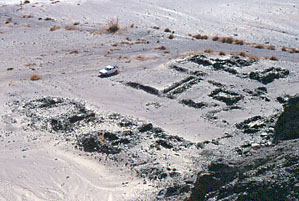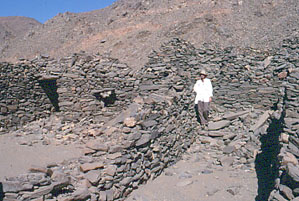|
The southern part of the settlement in Wadi Gamal
was obviously built as a road station, probably to accommodate the traffic
to and from the Mons Smaragdus area:
|
|
The largest building in the settlement in Wadi Gamal,
in a small gully north of the main wadi, had a wall built around it which
in places was still standing to its original height:
|
|
|
|
|

|
|

|
|
|
|
|
|
|
|
|
Objective of visit:
|
|
To draw a measured plan of the site and study the surface
remains (including the ceramic finds). |
|
Date of visit:
|
|
- January 2001 |
|
Fellow visitors:
|
|
Prof.Dr. Steve Sidebotham (University of Delaware), Wayne
Sawtell and Jennifer Gates (Berenike Project). |
| Results: |
|
A survey was performed using the Global Positioning System,
a theodolite and steel tape measures. Off-site assistance was given by
pottery expert Dr. Roberta Tomber (Museum of London). No excavations took
place. A full publication of this site is pending. |
| Approximate position and date
of the site: |
|
The settlement in Wadi Gamal is in the southern part
of the Egyptian Eastern desert, south of the Edfu-Marsa Alam asphalt road,
between the Mons Smaragdus area and the settlement in Kab Marfu'a. Surface
pottery dated to the Ptolemaic period (ca. 330 - 30 BC). |
| Short description of the site: |
|
The settlement in Wadi Gamal was most likely a stop on
the ancient road from the emerald (beryl) mines in the Mons Smaragdus area
to the Nile. Here travelers could find water, food and shelter for the
night. |
| Additional remarks: |
|
Judging by the size as well as the lay-out of the remaining
buildings, including the animal lines, the settlement in Wadi Gamal was
of major importance to the ancient traffic. Our work was sponsored by the
Berenike Project and private donors. |
| HOME |
|
|
 |
|
|